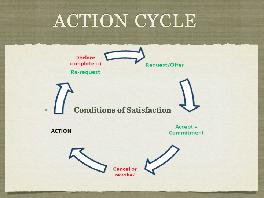Language
“Sticks and stones can only break your bones, but words and pictures can REALLY screw you up” – adopted from Stuart Heller
Embodiment primarily concerns the present moment while language is how we coordinate action in the future. We are linguistic creatures and combining the two can be very powerful. All linguistic tendencies (e.g. to say yes and no) are embodied so it is never just about the words. I have found two linguistics systems helpful – ontological linguistics from Chile and NonViolent Communication which is used in peace and mediation work and founded by Marshall Rosenberg. The former is helpful for getting things done (it) and the latter for self connection and relationships (I,we). There are many others good systems.
Language as Action
We live “in” language and it is a form of action. Using language effectively gets the job done, builds relationships and means you will have integrity or not. This “ontological” (relating to being) approach to language defines various “speech acts”:
Declarations
A powerful way of creating different futures. E.g. “within ten years we will put a man on the moon.” We worked with these in module one.
Requests
Requests involve a requester and recipient/s, embodied mood, context and conditions of satisfaction (what is wanted). Offers are similar to requests in structure. We embody our offer as embodied facilitators. There are four responses to a request:
– accept
– decline
– commit to commit
– counter offer
Hunt and kill maybes.
There are various ways to work with these through the body to reveal tendencies and build new possibilities (meta-algorithm). When requests are accepted we have promises, commitments and agreements.

Assertions and assessments
Distinguishing between facts and opinions is a critical skill for leadership and coaching. In NVC this is called observations vs evaluations and distinguishing them can be surprisingly hard!
NonViolent Communication
NVC integrates work with feelings and underlying needs into work with observations and requests.
Some ways of working with language
• Embodied declarations
• Yin and yang walking while speaking commitment
• Forms for requests
• Saying yes and no in different embodiments
• Yes, no, maybe game
• Feedback on the embodiment of your offer
• Advocate listener exercise (Palmer)
• Declarations – from module one
• Etc. Make your own up.
Sources – Fernando Flores, Wendy Palmer, Newfield Network, Richard Strozzi-Heckler, Chalmers Brothers & Marshall Rosenberg
Imagery – Embodied Imagination
Imagination is embodied, not just mental. The body responds well to imagery which can activate complex micro and macro movement patterns that would be very hard to figure-out through conscious control of muscle groups. We all create pictures within the mind and these create powerful effects in relation to embodiment. We touched on this learning centring and now it’s time to go into more detail. As we are doing this anyway, the question becomes how do we do it more consciously and skilfully. Awareness and choices as ever. Using images works really well as the body is primarily linked to the unconscious which works through image and metaphor. By connecting to archetypal imagery particularly, we unleash a wealth of associations. If one wants to embody a more earthy quality for example, one can consciously control every aspect of posture, movement, awareness of each body part, holding patterns etc or one can picture oneself as a mountain and many of these patterns will fall into place. Imagery is not so much “mental imagery” as a shortcut into all the aspects of embodiment we have been working with. Imagination is often visual but can also come in the form of tastes, smells and music.
Principles of somatic imagery – personally and culturally appropriate
– personally and culturally appropriate
– quality most important
– targeted (clean)
– experiential – feedback
Some Examples
Dinosaur tail, wearing cloak, having a crown, “kitten” tummy breathing, anchors for grounding
Mental imagery vs felt-imagery
Embodied imagination and creating a mental image without “tasting” it are different.
Effective Visualisation Themes
• Animals (like kung-fu) and plants.
• Landscapes and Nature – these work well for most people e.g. mountains, rivers, clouds/wind and fire itself for the four elements. Or mud to combine water and earth or steam for air and water for example.
• Colours. Different colours produce different embodiments – a bright sunflower yellow will feel very different from a dark navy blue for example (see Paul Linden for more on this). There is a cultural element to this but I have found one can guess which colour someone is “doing”.
• Foods – honey and liquid chocolate for example are a familiar quality.
• Life stage – E.g “like a five-year old”.
• Vehicles – Good for movement patterns – e.g. “like a kite/train/canoe”.
• Familiar social situations or roles – E.g. “like you were on a first date” “like a queen”.
• Modelling famous people.
• Archetypes – monarch, fool/sage, warrior and lover are a classic set, there are many others.
• Electricity – imagining current helps bring awareness and direct intention.
• Others – The possibilities are huge.
Watch Integration Training videos here:
Leadership presentation and embodiment
For more info on our training courses, click here